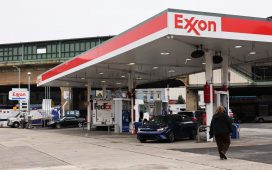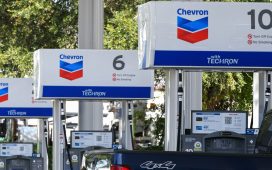The Alerian MLP Infrastructure Index has dropped more than 20 percent since late July. It’s now just a few percentage points above the early 2016 low, and 60 percent under the mid-2014 high.
The chief catalyst for the most recent decline: Growing concern that falling North American rig deployment will stall oil and gas production in 2020. This raises risk midstream volumes will slacken, reducing company revenues and ultimately triggering distribution cuts.

Refinery factory oil storage tank and pipeline steel at night.
We don’t deny the danger. But third quarter earnings results and updated guidance clearly show vulnerability is not evenly spread across the sector. In fact, a growing number of master limited partnerships appear increasingly able to resist whatever weakness the coming year brings.
After billing themselves as quasi-utilities earlier in the decade, it’s fair to say MLPs have a credibility problem. So it’s no wonder many investors are now considering cashing out in this selloff, even from industry blue chips like Enterprise Products Partners (EPD).
Our strong advice is to not give into the temptation. In fact, there’s unlikely to be a better opportunity to establish positions in well-run, historically solid US midstream energy companies. And that definitely includes MLPs.
We’ve contended for some time that 70 publicly traded companies plus private capital entities is too many individual owners of US pipelines, storage, gathering and processing assets. Canada by contrast has less than a half dozen sector players of consequence.
The continued success of Canadian midstreams like Pembina Pipeline Corp (PPL, PBA) reliably growing assets, cash flows and dividends—despite Alberta’s ongoing depression—testifies to sector resilience when companies have sufficient scale, diversification and financial strength. And Pembina has rewarded shareholders with a 14.6 percent annual return over the past decade.
That compares to the Alerian Index’ 10-year performance, which is actually underwater by roughly 17 percent before distributions. And it’s equally a warning to investors that until there’s more consolidation, there will be more US midstream pain.
There are, however, a number of sector companies already identifiable as long-term winners. That list starts with Enterprise and Magellan Midstream Partners (MMP), arguably the only major US MLPs that were financially prepared for a downturn when oil prices first broke below $100 a barrel in August 2014.
Both have since further increased resistance to cyclical pressures by reducing debt leverage, while focusing on their most profitable assets. Enterprise halved its rate of distribution growth in mid-2017 and as a result has built distributable cash flow coverage to 1.7 times. Magellan’s DCF coverage is expected to near 1.4 times this year, with free cash flow coverage of nearly 1.2 times in 2020.
That’s a significant cushion for dividends against a possible drop in revenue next year, which itself is highly unlikely due to both MLPs’ strong counterparty profiles and lack of exposure to producer default risk. Neither is leverage a significant threat, with Enterprise’s debt-to-EBITDA ratio just 3.2 times and Magellan’s 2.8 times.
There are also a number of MLPs and midstream companies that cracked in 2014-16 but have since taken painful, necessary steps to increase resilience. For example, Energy Transfer LP (ET) has cut its distribution twice by merging units. But coupled with higher revenue from new projects, third quarter distributable cash flow coverage rose to 1.88 times and free cash flow coverage to 1.3 times. Debt to EBITDA has been cut to just 3.63 times.
Incentive distribution rights paid to general partners have long been a cause of investor concern about MLPs. But Enterprise, Energy Transfer and Magellan are now IDR-free after subsuming general partners. So are Crestwood Equity Partners (CEQP) and NuStar Energy LP (NS).
Plains GP Holdings’ (PAGP) swap of its GP interest for common units eliminated IDRs at Plains All-America Pipeline (PAA). And MPLX LP (MPLX) is also IDR-free after Marathon Petroleum (MPC) did the same thing last year.
Use of distributable cash flow as a primary profit metric was never an issue when MLPs were riding high but now draws criticism. So does the long-held practice of growing what are already generous distributions, instead of buying back shares. And capital spending allows draws deep skepticism, even when projects are for all practical purposes pre-contracted.
Common units of Enterprise and Magellan yield nearly 7 percent, while others midstreams pay out 10 percent or more. That makes raising new equity prohibitively expensive for most MLPs. And since debt is only a slightly better option, there’s a premium on “self-funding” projects with cash from operations and/or proceeds from asset sales.
Self-funding, however, is precisely what at least a dozen MLPs and other midstream companies are doing now. And so long as management executes on new projects and maintains profitability of operating assets next year, there will be even more cash flow to pay dividends, buy back stock and/or cut debt.
The next several quarters will pose a significant stress test for all North American midstream companies. That’s particularly true for MLPs, given the reputational damage they’ve sustained the past few years.
Not all will pass, as cost cutting efforts by major customers shrink revenue, triggering distribution cuts and quite possibly bankruptcies. But companies that do stay on course will prove their resilience to investors. And doing so, they’ll repair reputational damage and bring back the investors whose exodus has triggered this year’s declines.
We’ll bet our bottom dollar Enterprise Products Partners will be among them. The partnership has increased its distribution 22 consecutive years, a period that includes multiple energy price cycles.
Units traded in the low 30s as recently as July. That’s a solid target for first half 2020. But as Enterprise expands energy export-focused operations going forward, we expect a move past the low 40s. That’s a level last reached in mid-2014, when the partnership’s distribution was 20 percent below the current 44.25 cents per quarter.
For more bargain-priced midstream, see the current issue of Energy and Income Advisor.








